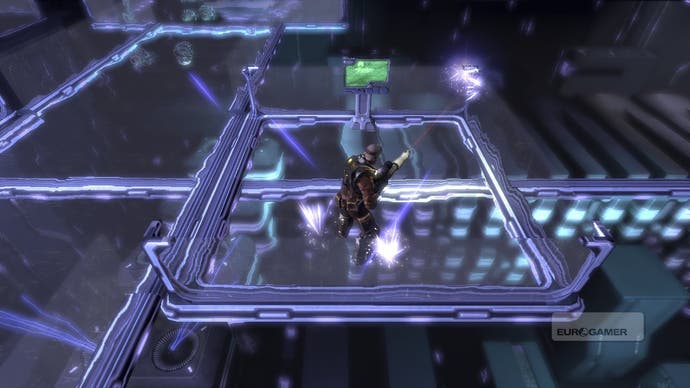Alien Breed Evolution: Episode One
Space doubt.
Retro revamps can be a harrowing business. For every Pac-Man Championship Edition there's an Alien Syndrome, and a Golden Axe: Beast Rider, and a Final Fight: Streetwise, usually in those distressing proportions.
The problem is down to the approach. Developers often find themselves caught between two stools, on the one hand trying to retain the essence of what made the original so appealing, while also trying to update it to appeal to modern gamers. They routinely end up failing at both.
Team 17's long-overdue Alien Breed reboot initially takes a no-nonsense approach, avoiding the temptation to tinker too much with the old top-down shooter formula. This 'Evolution' lives up to its title, with most of its central gameplay principles retained, and a suitably lavish, atmospheric setting provided for the alien carnage.
As tends to be the case with any Alien-inspired sci-fi romp, you spend the entirety of the adventure aboard a stricken vessel, wandering its darkened corridors by torchlight with only the omnipresent threat of face-huggers and insectoid Maulers bursting forth at any moment for company. Introduced via a series of stylish comic frames, the game reveals that your spacecraft collided with a much larger ghost ship during hyperspace, and now half the structure is either on fire or in bits.

Much like the classic Amiga original (itself heavily inspired by top-down eighties arcade games like Alien Syndrome, Robotron and Smash TV), you spend most of your time fending off a relentless assault of aggressive aliens while also trying to hunt down keycards, and rebooting generators and mainframe terminals.
Team 17 has done a fantastic job of delivering the requisite moody atmosphere, the crumbling remnants of the ship awash with delightful incidental detail like gigantic throbbing generators visible beneath the metal gantries. Built with Unreal Engine 3, excellent lighting and particle effects add conviction to an already highly impressive spectacle, and few will have complaints about the overall artistic direction.
The multidirectional combat system is slick and intuitive from the off, too, easily allowing you to move and fire independently. With basic movement (and flashlight direction) mapped to the left stick and shot direction on the right, you're afforded a satisfying degree of precision - aided in part by the red laser sight that points the way.

Enemies often erupt in waves from all sides, so the ability to whip around instantly and take care of new targets is a life-saver. In this sense, the new two-stick controls are a vast improvement on the original, and ensure that the gunplay remains enjoyable throughout the four-hour, five-chapter single-player campaign.
The campaign has been expanded far beyond the scope of the original Alien Breeds, and you'll soon spot a few modern concessions, such as save stations where you can store your progress, and a noticeably more forgiving difficulty curve which ensures that progressing right through the game shouldn't pose too much of a problem.
That said, the decision to leave saving progress up to the player means that you have to be mindful to take advantage whenever save stations appear - lest you get caught off-guard by a sudden ambush and lose 20 minutes of painstaking progress. It does at least ensure a much-needed degree of tension at all times, but the potential for frustration is obvious.
Rather than go for a direct rehash of the original top-down viewpoint, Alien Breed Evolution also opts for an isometric-style approach, with the useful ability to rotate the viewpoint in eight increments via LB and RB. But despite the game occasionally zooming into the action at predefined sections, you can't fiddle with the perspective yourself.

